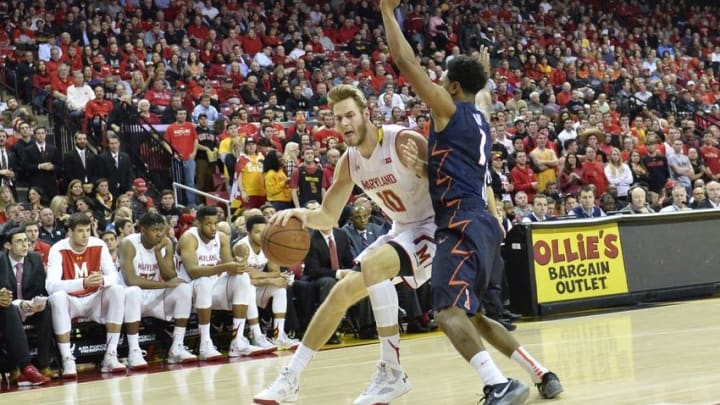Maryland Basketball: Jake Layman could be the total package
By Chris Bengel

Jake Layman won’t be a first round pick in Thursday’s NBA Draft.
However, that doesn’t mean that he doesn’t have the potential to be a force at the NBA level.
Layman was part of coach Mark Turgeon‘s first recruiting class in 2012. Turgeon actually was able to land a pledge from Layman the night after the Maryland football team upset Miami (Fla.) back in 2011.
Layman was a four-star recruit in the 2012 class, but wasn’t the highest Maryland signee in that class. Center Shaquille Cleare was rated as the No. 41 recruit in 247Sports’ composite rankings.
Upon his arrival at Maryland, Layman was primarily a perimeter shooter that would settle for jump shots. As a freshman, he only averaged 5.5 points and shot just 29.9 percent from beyond the arc.
As a sophomore, Layman increased his scoring average to 11.7 points per contest. However, his three-point attempts also rose to 5.2 a night.
While Layman was a great athlete and an above-average shooter, he didn’t seem to want to put the ball on the floor and drive to the rim. The question always was if he would ever take that next step and become an elite player.
It was almost as if a light bulb went on in Layman’s head during his junior and senior seasons.
Layman attempted just 3.4 threes per game as a junior and 4.0 as a senior. He shot a combined 38.7 percent from long-range over his final two seasons in College Park.
With Layman growing a ton over the past years, why exactly is he so dangerous?
The inside-out game is what makes Layman so lethal on the offensive end.
As was mentioned above, Layman came to College Park with a strong perimeter game and not a whole lot else. He almost seemed to be afraid to put the basketball on the floor and attack the basket.
Now, if Layman’s shot isn’t there, he has no problem putting the ball on deck. Part of the reason for that is his ability as a ball-handler.
If you watch the above play against Kansas, Layman works off the screen that was set by Robert Carter. Layman then makes his way to the top of the key and dribbles towards the rim for the emphatic slam dunk.
When his shot is there on the perimeter, Layman is rarely ever afraid to take it.
Layman really excels at coming off screens. If Layman comes off a set screen, he can oftentimes catch the ball and release right away.
Layman possesses a very fluid jump shot that he can hit with regularity, especially from the perimeter. As a senior, he shot 39.6 percent from beyond the arc and really showed his ability to score in bunches.
As you can see in the video above, the extra pass is very important when Layman is wide-open. Layman has the necessary speed to get to his spot and if the extra pass is made, he most likely is going to knock down the open three.
Layman is known for his offensive acumen, but he is also a strong defender.
His length combined with his speed is a huge asset on defense. Layman was long arms to help make opposing players uncomfortable and his speed allows him recover very quickly and use those long arms to alter shots.
Layman can block his fair share of shots despite not being primarily a frontcourt player. As a senior, the Massachusetts native rejected 36 shots, which was a career-high.
His ability to guard multiple positions facts until his shot blocking prowess. On the perimeter, Layman uses his long arms to deny jump shots.
Layman’s post defense also allows him to have ample opportunities to block shots. The close proximity combined with sometimes guarding smaller forwards, gives Layman a chance to alter and reject shots.
Layman certainly has several tools that make him extremely attractive to NBA teams. It’s very clear that Layman is going to be selected in the early-to-mid second round.
During his time at Maryland, it was evident how versatile Layman could be and that he could potentially be an NBA player one day. After four years of development under the Maryland coaching staff, Layman will realize his dream on Thursday evening.
Next: Robert Carter's versatility is a major selling point
It could just be the beginning of a very long and successful journey for the former Terp.